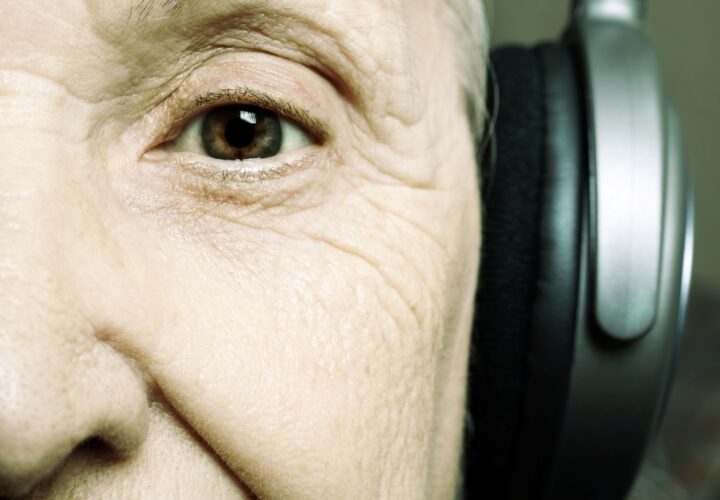Could a headset with flashing lights and sounds stimulate brain waves and treat Alzheimer’s? Cognito’s Phase 3 trial on such a device is trying to answer that question. Neuropsychologist Dr. Michelle Papka, the trial’s principal investigator and founder of the CRCNJ, explains the science.
This interview was produced by Being Patient with support provided by Cognito Therapeutics.
Researchers and technology companies are investigating whether non-invasive electromagnetic, visual, and auditory stimulation can treat Alzheimer’s disease. But what do we know now about these emerging non-drug interventions and what they can do for the brain?
Cognito Therapeutics, in particular, is probing the connection between visual and auditory stimulation and gamma waves in the brain and treating Alzheimer’s disease with an experimental headset called the SPECTRIS AD. Now, in phase-three clinical trials with the HOPE study, they’re recruiting individuals with mid-stage Alzheimer’s disease.
Dr. Michelle Papka, founder and president of the Cognitive and Research Center of New Jersey (CRCNJ), is working on the trial herself as principal investigator and advisor to Cognito Therapeutics. Involved in Phase 1 and 2 she sees the technology’s potential as a key part of potentially treating Alzheimer’s disease in the future.
“This offers a much lower-risk option that would not burden our medical system in the same way as some of these other drugs,” Papka explained. “It could be adjunct therapy to other therapies. It could offer possibilities for people who cannot be on those monoclonal antibody drugs.”
Papka, a neuropsychologist, psychotherapist, and researcher, has over 30 years of combined experience specializing in aging, Alzheimer’s, and dementia. For over 15 years, she has also served as the principal investigator on industry-sponsored clinical trials for Alzheimer’s disease and age-related cognitive impairment. She has a private clinical neuropsychology practice in New Jersey.
Papka joined Being Patient founder Deborah Kan for a conversation about the trial, the science behind neuromodulation, headsets like the Spectris AD, and the future of this type of treatment. Read or watch the full conversation below.
CORRECTION, 13 FEB. 2025, 12:02 A.M. – In the original live interview, when asked about people on monoclonal antibody drugs and whether they could enter the trial if they were off the drugs, Papka answered that she thought they might be able to enter or use the treatment after one year off the drugs or a “one-year washout.” After the talk, Papka clarified that while a one-year washout was previously permitted in the study, patients with prior exposure to monoclonal antibodies are currently excluded. This transcript has been updated to correct the error.
Being Patient: There are a lot of light and sound therapy headsets on the market, but Cognito’s SPECTRIS AD is specifically under trial to treat Alzheimer’s disease. Is this the first headset aimed explicitly at Alzheimer’s?
Dr. Michelle Papka: It is. One of the things that I always like to point out when I meet with patients and families about biotechnology— and I also say this about supplements and other alternative treatments for Alzheimer’s disease— is that we do have an empirical process, a way that we test things for the FDA to determine whether or not this is something that works and something safe for the public to use.
I always want to be supportive and have consumers be knowledgeable and educated about the information and data behind what they may be considering using. While I’m not aware of all the different headsets that are available, I have had patients come in and tell me that they’re finding things on Amazon and [places] like that. But, this particular piece of biotechnology is being tested in an empirical process to see if it works, if it’s effective, and if so, in what way [it is] effective.
Being Patient: What is neuromodulation, and does it apply to this specific headset?
Papka: Neuromodulation, in a very general way of understanding, is where [you’re] modulating neurons, [which are] the cells in the central nervous system. So far, the data that we have on this device, based on previous studies, is that people who got active treatment seem to have less volume loss in their brains.
The brain atrophies, just like other muscles do, and this happens as a result of normal aging. In Alzheimer’s disease, where you have a pathology in the brain, the brain volume loss happens at an accelerated rate. We might infer, as patients have maintained brain volume, that [the device] is doing something to the neurons.
“The brain atrophies, just like other
muscles do, and this happens as a
result of normal aging. In Alzheimer’s
disease, where you have a pathology in
the brain, the brain volume loss
happens at an accelerated rate.”
Being Patient: This technology uses light and sound therapy to stimulate gamma waves in the brain. What does that do, and how does it work?
Papka: The apparatus is providing sensory stimulation. It’s the flashing lights, and the person is wearing headphones, where they’re also getting auditory stimulation. It’s visual stimulation and auditory stimulation.
The stimulation [is] calibrated per patient, so it’s catered for them to ensure that the level of the stimulation is causing a certain brain wave activity. We want to make sure that the patient is actually responding to it, so it induces this gamma wave activity to have this sort of steady wave activity that we know is involved in learning and memory. These gamma brain waves are utilized in learning and memory.
Being Patient: Is this technology an alternative to other treatments like Leqembi, or could it potentially be used in combination with other drug therapies?
Papka: That’s such a great question. This is a clinical trial that is ongoing, and we are not including people who are currently on drugs like Leqembi, so we don’t know the answer to that. The reason that we’re not including them is because, [in these] clinical trials, we want to test one treatment at a time.
We don’t know the effect, but the idea would be, over time, that, hopefully, we will have people on what we call combination therapy. So, they may be on a monoclonal antibody treatment, like Kisunla or another treatment, and then also be able to be on this treatment. Because these treatments are working by different mechanisms of action, we would like for people to be on a combination therapy with different mechanisms of action, but we also have to test the safety of that.
Being Patient: Tell us why people on drugs like memantine were excluded from the HOPE study. Should people speak to their doctors about stopping medications like these before entering the trial?
Papka: For every clinical trial, including this one, there are lists of medications people can and cannot be on. For this particular trial, somebody could be on Aricept or one of these cholinesterase inhibitors but not on memantine, Leqembi, Kisunla, or newer drugs.
“Because these treatments are working by
different mechanisms of action, we would
like for people to be on a combination
therapy with different mechanisms of action,
but we also have to test the safety.”
When this study was designed, I don’t think [those drugs] had been FDA-approved yet, certainly not Kisunla. For each trial, we just have different inclusion and exclusion criteria. The question of whether or not to go off memantine or Namenda to be in the trial is something that I recommend discussing with the treating physician.
We have had patients enroll in the trial at our site who had been on Namenda and were willing or wanted to go off it. [They], in discussion with the treating physician, made the decision to do that. I recommend a discussion; [if] it’s a potential option and everybody agrees, that’s a good course of action.
Being Patient: The SPECTRIS AD is in its third trial stage, so it may be a little early to know outcomes, but what have you been seeing? Has there been a reduction in brain shrinkage and amyloid? What do we know about efficacy?
Papka: In the phase two trial, the OVERTURE trial, some of the initial rationale of that trial was that perhaps this would help reduce amyloid in the brain. While that trial did not provide evidence that being on active treatment reduced the amyloid burden in the brain, it did show that people who got active treatment had less brain volume loss than people who got the placebo.
Those who got the active treatment also had a slower cognitive decline and a slower decline in daily living skills. So, we know that it is doing something in the brain that is helping to preserve brain mass and functioning.
Being Patient: What were the criteria for entering the trial for this particular study? Do participants have Alzheimer’s?
Papka: [In] this current study, the HOPE trial, we are still enrolling patients with moderate symptoms of Alzheimer’s disease. It was initially enrolling patients with mild and moderate symptoms. The study is open now only to people with moderate symptoms. There aren’t many studies for people [with] moderate symptoms, so it’s exciting to offer this as a potential opportunity.
According to the protocol, the patient will get a blood biomarker [test]. Among other types of testing and criteria that would happen during a screening visit, we will do a blood draw. We are looking at their blood p-Tau measure. The blood p-Tau measure can [indicate] whether or not there are plaques and tangles forming in the brain.
If the patient meets a certain cut-off on the blood p-Tau measure, they would be eligible to move forward and continue in the screening and the study. There are different criteria that the patient has to meet, but the biological criteria to help establish that this person has underlying Alzheimer’s disease pathology is the blood test.
Being Patient: How do the mechanics of the study work? How long and often do patients need to wear the headset? Can they do it at home?
Papka: One great feature about the study and utilizing this type of treatment is that it is done at home. They use the device for an hour a day. For patients who may travel, they can use it wherever they’re going.
“There aren’t many studies for people [with]
moderate symptoms, so it’s exciting to
offer this as a potential opportunity.”
It’s one hour a day, and they use it at home, and they come to the research site about once every three months. When they come into the research site, we’re doing all kinds of other procedures and testing, but the actual treatment sessions occur wherever is convenient for the patient.
Being Patient: Tell me about gamma waves and what they do. How did researchers discover that you can stimulate them with light and sound?
Papka: The basis for this was animal studies. There are different brain wave activities in the brain, and gamma is one of them. We know, based on animal studies, that we can induce this steady gamma wave. These steady brain waves are important to functioning.
This type of brain wave, the gamma brain wave, in particular, is important to learning and memory. It was initially learned in animal studies, and then this multidisciplinary team at MIT developed this apparatus to use with people.
“The gamma brain wave, in particular, is
important to learning and memory. It was
initially learned in animal studies, and
then this multidisciplinary team at
MIT developed this apparatus to
use with people.”
I remember meeting with the Cognito group over time at meetings because, as I mentioned, we also did the first study, which is more of a proof of concept. I was wondering, “It’s one thing to do this in animal studies, but will people sit and do this for an hour wearing these glasses and headsets? Will people be compliant?”
People, in general, really [will]. Our experience in doing the studies is that people find one hour a day, and they sit and do it. Some people have come in and described it as being relaxing. They were able to come up with a device that people can use and hopefully will benefit from.
Exploring Flashing Lights and Sounds to Slow Alzheimer’s Brain Shrinkage
Being Patient: Depending on the results from this study and the following study, if SPECTRIS AD is deemed effective as a treatment for Alzheimer’s, do you think the technology will be tested if it’s a good option for people interested in preventing brain shrinkage and improving brain health overall?
Papka: Yes. One of the things that I think is very exciting about the finding from the OVERTURE study about this affecting brain volume loss is that it may [apply] not just to Alzheimer’s disease but to other types of neurodegenerative diseases and, to your point, potentially normal aging, where we know there’s brain volume loss as well.
We don’t know the answer to those questions because, in a research study, we try to have a very defined population so that we [can] ask specific questions and look at the data to get specific answers. But those are certainly things that we should look into in the future.
I hope the Cognito team will because there can be lots of widespread applications. Because this is an intervention that is non-invasive, it’s very safe. It’s very inclusive in terms of types of medical conditions or taking other types of medications.
“Imagine if you could go to
your pharmacy, get one of these, and
utilize it for all different purposes.”
Of course, there are restrictions, [but] they’re much less than other drugs and interventions I’ve worked on in terms of clinical trials. Imagine if you could go to your pharmacy, get one of these, and utilize it for all different purposes. I think it’s a wonderful option.
Being Patient: Do you need to stay on this light and sound therapy indefinitely, or are you determining if there is a limited amount of time you would need to wear the headset?
Papka: We don’t know the answer to that. We know the effects over the time frame of somebody being in the study. Whether or not someone has to keep using it, or could they potentially, at some point, instead of using it seven days a week, use it three days a week and maintain the same effect— those are all great questions that need to be studied.
Being Patient: What types of cognitive testing do you do in the study? Is it consistent with other types of trials for Alzheimer’s that you run?
Papka: The mini-mental status exam is very often used, not just in clinical trials but also in clinical practice. The mini-mental status exam has, for one piece of it, different items, and there are differences in that. In one of them, you’re asked to spell a particular word backward, and in another version, you’re asked to count in what we call serial sevens.
There are differences, but the mini-mental status exam is often used in clinical trials. There’s another scale similar to the mini-mental status exam called the MOCA, [which] is sometimes used, but the mini-mental status exam is very commonly used. The other cognitive scales that are being used in this study, I would say, are pretty similar and consistent with most other trials that we are conducting.
Being Patient: If the studies do confirm that SPECTRIS AD can treat Alzheimer’s disease, what does this mean for the future, and what does this mean for treatments?
Papka: Well, it’s extremely exciting to have a non-invasive treatment that would hopefully [be] accessible to everyone. I also think the fact that it addresses a mechanism of action [different from] other drugs that are in the pipeline or that have already been FDA-approved is getting us closer and closer to combination treatment.
If you look at some of the more recently approved drugs for Alzheimer’s disease, it is also extremely exciting to have disease-modifying drugs. They are more expensive. They involve healthcare teams to be able to give people these drugs safely and to monitor them.
While I’m all in favor and very excited about that, this offers a much lower-risk option that would not burden our medical system in the same way as some of these other drugs. It could be adjunct therapy to other therapies. It could offer possibilities for people who cannot be on those monoclonal antibody drugs.
“I also think the fact that it addresses a
mechanism of action [different from] other drugs
that are in the pipeline or that have already
been FDA-approved is getting us closer and
closer to combination treatment.”
For some people, those drugs are too risky because of some of the potential side effects. This opens up another option as either a sole treatment for people who can’t take these other drugs for whatever reason, also the monoclonal antibody drugs and many other drugs that are being studied are for people very early on.
There’s a lot of focus on early intervention. This is a treatment that could be helpful early on and also potentially even as the disease progresses. All of those things provide an opportunity that doesn’t currently exist.
Being Patient: Do we know anything about the cost and the timeline of these clinical trials?
Papka: It’s free of cost if you’re in a clinical trial. The device is not on the market, so it’s not available to purchase. If you qualify for the study, it will be made available to you free of cost when you participate in the study.
Each person’s participation in the double-blinded phase is a year, and then there’s an opportunity to be in an open-label extension. By the time we’re done recruiting everybody and everybody finishes their one-year double-blind, then we’ll have the results of the study.
The study is almost fully enrolled. There’s some opportunity, as I mentioned, for people who have moderate symptoms to still screen for the study. If there are listeners who are thinking about it for themselves or someone [else], I always tell people: don’t wait.
Go in and start the screening process because once you’ve started the screening process, you have the opportunity to decide to continue if you’re eligible. When studies close, they close, and then the opportunity isn’t there anymore.
Katy Koop is a writer and theater artist based in Raleigh, NC.






How does one apply to see if they are eligible for the trial
Hi Lori, thank you for reaching out. The study is open now only to people with moderate symptoms. If the patient meets a certain cut-off on the blood p-Tau measure, they would be eligible to move forward and continue in the screening and the study. You can inquire about joining the study directly with Cognito here: https://www.hopestudyforad.com/ – take care.
Where do I find out more about signing up for this trial? (for my husband). He has been diagnosed with early onset/early stage alzheimers
Hi Marie, thank you for reaching out. You can learn more and inquire about joining the HOPE study directly with Cognito Therapeutics here: https://www.hopestudyforad.com/ – take care.
I am presently on generic form of aircept for treating early phases of dementia symptoms. My MS auto immune disease has caused my memory impairment.
Hi Kathryn, thank you for sharing. Managing memory challenges alongside MS can be difficult, but it’s great that you’re receiving treatment. You might find this article on Dr. Donald Weaver’s theory—exploring Alzheimer’s not as a brain disease but as an autoimmune condition—interesting: https://www.beingpatient.com/alzheimers-brain-autoimmune-disease-donald-weaver/?utm_source=organic&utm_medium=social – wishing you all the best.
There is no mention here of the Alzlife app, also under research investigation and available to those not formally enrolled in the study. It is a combination of 40 hz sound waves and flashing light, both generated by the app (for which one pays about $11 per month). The app also provides an array of games and a book library to engage the brain during the hour per day treatment. I think Being Patient needs to do an article on this treatment, since it is research-based and already available to everyone.
Hi Linda, thank you for sharing your thoughts! This article specifically focuses on Cognito Therapeutics and their research into visual and auditory stimulation using the experimental SPECTRIS AD headset. We appreciate you bringing up the Alzlife app, and we’ll certainly look into it. Thanks for being part of the conversation—take care!
There are already some easy-to-use products on the market with 40 Hz light and sound through the EVY platform, from Optoceutics?
Thank you for sharing, Sander. This article specifically discusses Cognito Therapeutics’ research into visual and auditory stimulation as a potential treatment for Alzheimer’s, focusing on their SPECTRIS AD headset, which is currently undergoing clinical trials. You can learn more about the study here: https://www.hopestudyforad.com/ – take care.